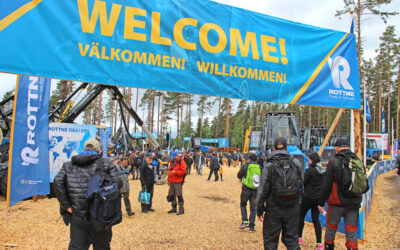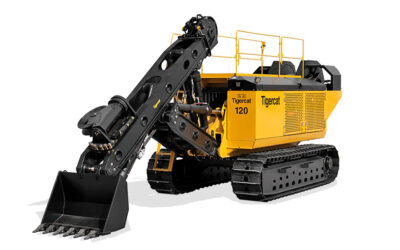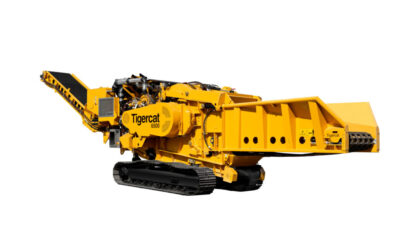Forestry Equipment Evolution
 Article by DK Knight, Co-Publisher/Executive Editor, Timber Harvesting February 2016
Article by DK Knight, Co-Publisher/Executive Editor, Timber Harvesting February 2016
While working on a new project under development by parent company Hatton-Brown Publishers, I recently immersed myself in our publication archives, sifting for logging equipment manufacturers, brands, model numbers, and more. I’ve been associated with the industry for 48 years, so I am quite familiar with forestry equipment evolution, but I soon realized that my memory had become a little rusty.
The review, which went back to only 1980, conjured up memories of companies, their people, machines, and events that took the industry from then to now.
For example, in the early ’80s Mike Harvey left Husky Hydraulics and created the Black Bear loader line, which faded quickly. In ’86 Husky was acquired by Precision Chipper Corp. Lynx, another loader brand, emerged at the hands of Hamp Childre, who had retired from Omark Industries, then owner of the eminent Prentice brand. The Lynx lasted little longer than the Black Bear. Once affiliated with Barko, Bob Holmes came out with the Holmes loader, which had attracted few buyers before Caterpillar acquired the line and in short order quietly buried it.
Several other loader brands were around for years, including Morbark, Lemco, Timberjack, Ramey, Peerless, Log Hog, Lucky and TimberKing. Brands such as Copeland, Cascade, Savage and United surfaced and sank during the ’70s. Some manufacturers retreated from the market and a few brands were acquired, i.e., Peerless by Timberjack, which was later acquired by John Deere. Caterpillar wound up with TimberKing, retiring the brand once the dust settled from its ’07 acquisition of Blount’s forestry equipment line, which included the Prentice offering. (Regarding Prentice, I recently learned of the passing of Bill Ostling, who was there when Leo Heikkenen introduced the industry’s first hydraulic knuckleoom loader. See page 6.)
Skidders have perhaps a less interesting history. Early players included Blue Ox, Garrett (Tree Farmer), Pettibone, Timberjack and Franklin, which were eventually joined by Clark (Ranger), John Deere, Cat, Athey, Case, IH, MRS, Massey-Ferguson, and Taylor. Tigercat joined the party in 1997, as did Morgan, a brand no longer manufactured. Franklin bought the Tree Farmer brand in 1990 and made both lines until Franklin shut down in 2010.
In the early ’00s Blount introduced the Prentice 490, a knockoff of the popular but sidelined Timberjack 460, and also made it available as the CTR 950. (Blount bought CTR in 1994). Cat ceased production of both makes and models when it acquired certain assets of Blount. Interestingly, the Ranger brand transitioned from Clark to VME, which sold it to Valmet, which sold it to Allied Systems, which eventually stopped skidder production. In the mid ’00s, Valmet introduced but quickly withdrew the 700 series of skidders.
Feller-buncher players at one time included Allied, Barko, Liebherr, Fabtek, Koehring, IH, Case, HyTec, Hydro-Ax, Franklin, Tree Farmer, Timbco, Timberjack, TimberKing and Valmet. Today’s TimberPro formerly did business as Timbco under headmaster Pat Crawford, who sold his tracked Timbco line to Valmet, whose forest machine products were later acquired by Komatsu. Barko once made a wheeled buncher and now makes a tracked version only; Blount bought Fabtek and rebranded both that line and Hydro-Ax as Prentice; HyTec capsized; Koehring was acquired by Timberjack; and Allied, Liebherr and IH withdrew from the market.
In the early ’80s Bell Equipment of South Africa joined with Morbark to introduce the first 3-wheel feller-buncher, known as the Mor-Bell, to the U.S. market. This partnership soon fell apart, and both Bell and Morbark later offered 3-wheelers of their own. Hydro-Ax, Gafner (later acquired by Valmet), CTR, and Franklin also marketed such machines. The 3-wheeler phenomenon ran its course, and Valmet, the last company to offer the machine, stopped production in late ’07. Note that Del Fab, which manufactured Valmet’s 3-wheeler under contract, is working toward bringing a 3-wheeler back to market as the Phoenix 703.
The Scene Today
Consolidation has eliminated many manufacturers, brands and dealers, but those who remain make and service products that dwarf yesterday’s offerings in terms of productivity, reliability, and durability. It’s common for many types of machines to last for 20,000 hours or so, meaning fewer sales. Last year new skidder sales were slightly less than 1,300 in the U.S.
These machines are also much larger in terms of size and price, the former due to the need to handle more mass (smaller trees), and the latter due in part to the emergence of the low emissions Tier 4f engine. Consider the example related by Tigercat President Tony Iarocci, who reports the company’s first skidder, the grapple-equipped 630, introduced in 1997, had a wheelbase of 150 in. and weighed 32,500 lbs. Its list price was approximately $175,000. The smallest grapple skidder offered by Tigercat today is the 610E, which has a 155 in. wheelbase, weighs 35,000 lbs. and lists for about $280,000.
Last year John Deere dropped its smallest skidder, the 548H, and introduced the market’s largest wheeled skidder, the 948L, which weighs 25 tons and has a 22.3 sq. ft. capacity grapple. It lists for around $400,000. For the record, in 2014 Cat introduced its largest skidder ever, the 555D.
Here are some other examples of the B-I-G logging equipment now available, based on web site data:
—Caterpillar’s largest tracked log loader is the 568 Forest Machine, which comes in at 106,128 lbs. in one version.
—Madill’s tracked 3000C log loader has 325 HP, weighs 100,000 lbs. and has a lifting capacity of almost 24 tons at 20 ft. The tilt version of its 2250C Series II tracked feller-buncher weighs 80,550 lbs. and can lift 22,000 lbs.
—As a clambunk forwarder, the TimberPro 840B weighs 54,000 lbs., is 32 ft. long and costs about $450,000.
And so it goes.
By the way, that new Hatton-Brown project will launch in the spring. Those who deal in used equipment will find it very useful.
Latest News
European Logging Show Elmia Wood Moves To Biennial Event
European Logging Show Elmia Wood Moves To Biennial Event Starting in 2025, Elmia Wood will host its trade fair every two years instead of every four. This change is made possible through a new land agreement at Bratteborgs gård, that extends until 2029, with a...
New From Tigercat: 120 Winch Assist
New From Tigercat: 120 Winch AssistThe new Tigercat 120 cable assist, the second model in Tigercat’s cable systems product line, leverages the company’s deep experience in steep slope harvesting systems to create cable systems that complement the ground based...
New From Tigercat: 6500 Chipper
New From Tigercat: 6500 ChipperTigercat has officially launched 6500 chipper after more than a year of successful field operations involving multiple retail units. The 6500 is a heavy-duty down-swing drum chipper designed for high production and maximum flexibility....
WANT MORE CONTENT?
Spanning seven decades since its inception in 1952, Timber Harvesting highlights innovative and successful logging operations across the U.S. and around the world. Timber Harvesting also emphasizes new technology and provides the best marketing vehicle for the industry’s suppliers to reach the largest number of loggers in North America and beyond.
Call Us: 800.669.5613



